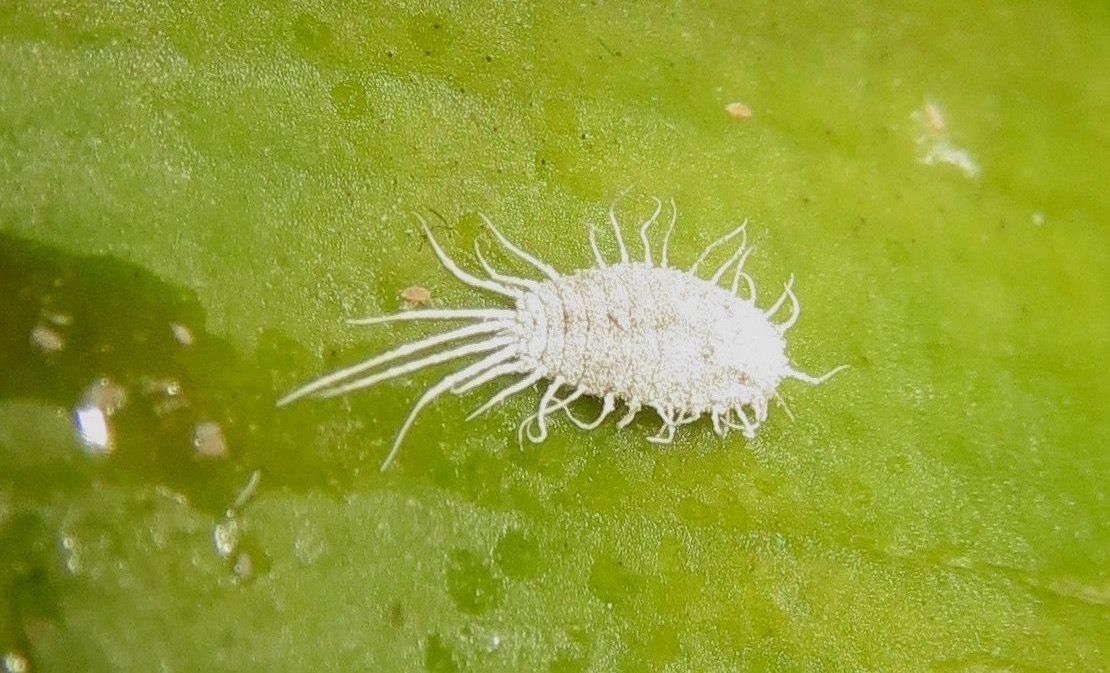Mealybugs
Mealybugs are a common pest that can infest many plants, causing damage and stress to your precious greenery.

These insects, part of the Pseudococcidae family, are known for their distinct white, fluffy appearance and ability to multiply rapidly, making infestations a severe concern for indoor and outdoor plant enthusiasts.
It is crucial to protect your plants and keep them healthy to learn how to identify mealybugs, apply effective treatments to eliminate their presence and take preventive measures to discourage future infestations.
In this article, we'll explore reliable methods to manage these pests and maintain the well-being of your plants.
Identifying Mealybugs
Physical Characteristics
Mealybugs are small, oval insects of the Pseudococcidae family with a white, waxy appearance.
Both males and females have a soft body covered in a powdery, meal-like wax, giving them their distinctive look.
Adult females tend to be larger than males and can have tail filaments, while males may have wings and be more segmented in appearance.
Both sexes have legs, but these features can be hard to see without magnification.

Signs of Infestation
Keep an eye out for the telltale signs of a mealybug infestation.
You'll likely notice their waxy, white presence on your plants, particularly along stem joints, leaf undersides, and hiding spots on your plants.
Another indicator is plant stress, like yellowing leaves or stunted growth, as mealybugs feed on plant sap and release honeydew.
This sticky substance can attract ants and lead to the growth of sooty mold on your plants.
Life Cycle of Mealybugs
Female mealybugs lay their eggs in a waxy material that protects them from the elements.
Once the eggs hatch, nymphs emerge and begin feeding on plant sap, undergoing several instars (growth stages) before they reach adulthood.
Male mealybugs are tiny, winged insects, while females are larger and wingless.
Both males and females contribute to the reproduction process, allowing the mealybug population to grow and continue their life cycle.
Throughout this cycle, mealybugs can cause damage to plants by injecting toxins and producing honeydew, leading to sooty mold growth.
To manage these pests, implement various control methods, such as biological, cultural, physical, and chemical treatments and prevention strategies.
Impact of Mealybugs on Plants
Damages Caused
Mealybugs feed on your plants by inserting their threadlike mouthparts into the leaves, stems, and other parts of the plant, sucking out sap and causing damage.
When they do this, leaves may become yellow and eventually fall off, leading to defoliation.
As mealybugs feed, they produce a sticky substance called honeydew which can attract ants or cause the growth of sooty mold, further harming the appearance and health of your plant.
In severe cases, mealybug infestations can lead to stunted growth, malformed fruit, and even the death of the plant.
Affected Plants
Mealybugs are capable of infesting a wide variety of plants, both indoors and outdoors.
They are most commonly found on perennial foliage plants but may occasionally infest flowering and bedding plants.
Warm, dry weather conditions are conducive to mealybug activity, so monitoring your plants regularly for signs of infestation is essential.
With proper identification and treatment measures, you can minimize the damage caused by mealybugs and maintain the health of your plants.
Mealybugs Treatment Methods
Chemical Treatments
To combat mealybugs, you can use insecticides such as ready-to-use pyrethroid-based sprays.
Treat all parts of the affected plants, including the undersides of leaves and stems.
Another option is a systemic insecticide, which is absorbed by the plant and can provide longer-lasting protection.
You can also mix water with isopropyl alcohol (rubbing alcohol) in a spray bottle at a 1:1 ratio and apply it directly to the mealybugs.
Be cautious when using this method, as it can cause leaf burn if applied in high concentrations or during extreme heat.
Natural Treatments
Neem oil is an organic pesticide that can help control mealybugs.
To use, dilute it with water according to the product label and spray it onto the affected plants, covering all surfaces thoroughly.
Try spraying the plants with water and dish soap for a non-toxic solution.
This can help break down the waxy coating on the mealybugs and make it easier for other treatments to penetrate.
Additionally, you can physically remove mealybugs with a soft brush or dab them with a cotton swab dipped in alcohol.
Preventing Mealybug Infestation
Protective Measures
You must maintain their overall health to protect your plants from mealybug infestation.
Ensure they receive proper sunlight, water, and nutrients. This enables them to withstand potential attacks more effectively.
Additionally, inspect your plants regularly and remove any infected parts promptly to prevent further spread.
Environmental Controls
Implementing environmental controls helps maintain a hostile environment for mealybugs, reducing their chances of infesting your plants.
Introducing beneficial insects, such as ladybugs and lacewings, can aid in controlling mealybug populations.
Moreover, keep the area around your plants clean and free from clutter, providing fewer hiding places for these pests.
Dealing with Other Related Pests
Interactions with Ants
Mealybugs have a symbiotic relationship with ants, where ants protect them from predators and receive honeydew in return.
To deal with both pests effectively, you should address the presence of ants by using ant baits or traps.
This will help remove their protection and make mealybugs more vulnerable to other treatments.
Similarities with Aphids and Scales
Like mealybugs, aphids and scales are plant-sucking insects that can cause damage to your plants by feeding on their sap.
They all produce a sticky substance called honeydew, which can promote the growth of sooty mold.
You can treat them with similar methods, such as introducing natural predators like ladybugs or releasing lacewings into your garden.
Additionally, insecticidal soaps or horticultural oils can help control these pests by suffocating them and disrupting their feeding activities.
Frequently Asked Questions
What are the symptoms of mealybug damage?
You may notice stunted growth, wilting, discoloration, and defoliation in plants affected by mealybugs. They feed on plant stems, which can cause these issues.
What are effective methods for controlling mealybugs?
Consistent treatment using organic pesticides, chemical pesticides, or physical control (like washing or brushing off) can help control mealybugs. Combining these methods can be effective in tackling infestations.
Can neem oil eliminate mealybugs?
Yes, neem oil can be an effective method for eliminating mealybugs. It is an organic pesticide that disrupts the insects' feeding and growth.
Are mealybugs dangerous to humans?
Mealybugs are not directly dangerous to humans; their primary concern is the damage they cause to plants. However, their presence may indicate the need for better plant care and pest management.
What is the best way to prevent mealybug infestations?
Regular monitoring and inspection of your plants is vital for preventing mealybug infestations. Early detection and removal of the pests can help prevent their spread to other plants.
How can you identify a mealybug?
Mealybugs are small insects from the Pseudococcidae family. You can identify them by their oval shape, white waxy covering, and cotton-like filaments that give them a "mealy" appearance.


